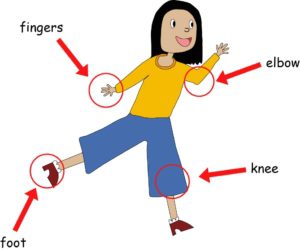Group Mirror
Contributed by Laura Borgwardt
![]()
![]()
Description
This physical warm-up activity invites students to practice being a leader and a follower while simultaneously teaching parts of the body and actions. It’s a great way to start building an ensemble.
Directions

Image credit: Jean Wong
- Invite students to form a circle.
- Instructions can be verbal or nonverbal.
- Verbal: “Put your hand on your head if you know what a mirror is. If I’m looking in my bathroom mirror at home while I’m brushing my teeth, show me what I would see. That’s right! I’d see myself, brushing my teeth. Today we’re going to do a Group Mirror. I’m going to be the leader, and everyone is going to follow me and do exactly what I do. Then I’m going to pass the leader role on to the person next to me, and they will be the new leader. We will continue around the circle until everyone has had a chance to lead. Our goal is to warm up our whole body, so if the person next to you shows us a move to warm up our ankles, maybe you can show us a move to warm up our knees!”
- Demonstrate movement that is easy/difficult to follow. Your goal as the leader is for everyone to be able to do the movement. Go slowly.
- The same move might look different in different bodies. Our goal as followers is to try to mirror the movement of the leader as closely as possible, to move in unison.
- Nonverbal: Gesture that students should watch and do what you do. When they start to mirror you, show them enthusiastically that they are doing it right!
- Reflection:
- “Why would we do a Group Mirror as a warm-up?”
- “What made this warm-up easy/hard?”
- “Are there ways the leader can help the group to make it easier? What did we need to do as followers to do the task well?”
- “Does your body feel warmed up and ready for class?”
- (If instructions were silent) “I didn’t tell you how to play the game—how did you know what I wanted you to do?”
Activity Extensions
- Chart body parts—draw an outline of a body and list the different parts that we need to warm up.
- Play music during the Group Mirror—slow, instrumental music works best for the first time.
- Use different styles of music to encourage creativity of movement.
- Use the instrumental version of a song that you will be teaching later in class to get the group familiar with the melody.
- Practice counting out loud to eight so that students get used to the way we phrase movements in choreography—you can also use this tool to know when to pass the leader role (e.g., each person leads for two counts of eight).
- You may need your music on a loop in case it takes longer to get around the circle (or have a second song prepped in the playlist). Or you can challenge the group by saying, “This song is five minutes long and we need to make it all the way around the circle. So can I be the leader for four and a half minutes? No! Share the air.”
- Have a clear motion or prop that is passed to indicate there is a new leader.
- Check out this Partner Mirror activity.
Transition into Activity
Try silent instructions for this warm-up. It increases the focus and infuses the class with a sense of mystery and play.
Transition out of Activity
Lead the group in two deep breaths, in and out. If you can get the music to fade out at this exact moment, you’re golden.
Classroom Arrangement
Level 1: In a circle (or online in our Zoom squares).
Level Up: Scattered around the room—you might not be able to see the leader directly, but if everyone is doing the same thing at the exact same time, we should stay together (like a flocking exercise).
Supports/Adaptive Materials/Tools
- You can side coach as necessary. Prompt them with a body part: “What could we do to warm up our shoulders/hips/head?”
- Say yes to all offers—if a student shrugs their shoulders, that is a great move to warm up our shoulders!
- Try using a timer or music so everyone has an equal opportunity to be a leader and a follower.
- Try doing the warm-up in a seated circle, on chairs or the floor. This inspires creativity of movement, is inclusive of wheelchair users, and can ground a high-energy group.
- Chart body parts—draw an outline of a body and choose the order for when movement of that body part will take place (one for each person).
- Useful Visual Vocabulary (downloadable).
Possible Roles for Classroom Professionals
- Model full participation
- DJ
- Chart body parts
Adjustments for Remote Instruction
![]()
This is a great activity for remote learning. Model how you can use your frame—small movements up close, moving toward and away from the camera, etc. Call out the name of the next leader.
